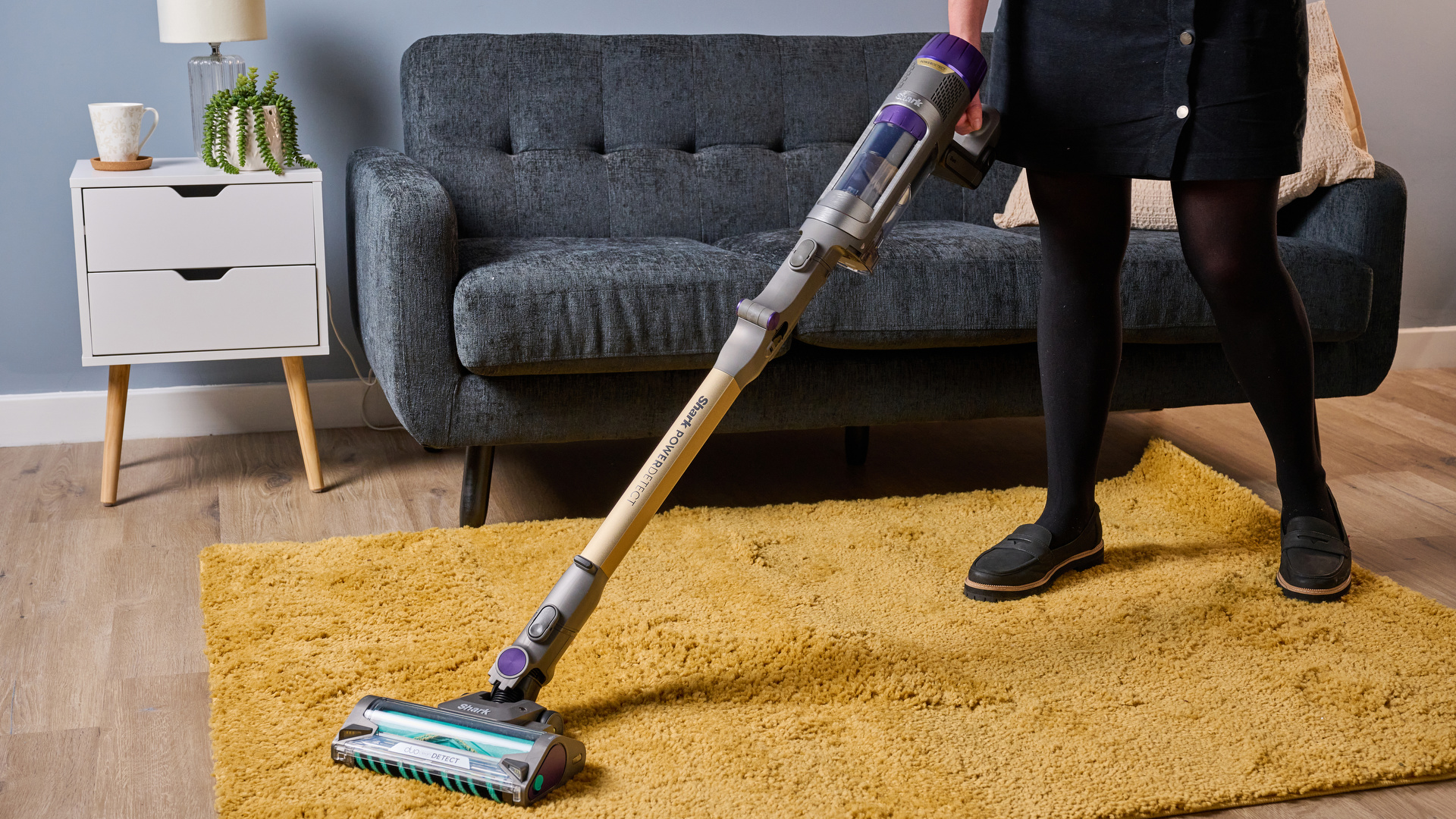
PowerDetect Cordless: two-minute review
This is the vacuum on its own:
US: Shark PowerDetect Cordless Stick Vacuum IP1251
UK: Shark PowerDetect Cordless Pet Vacuum Cleaner IP1251UKT
AU: Shark PowerDetect Cordless Stick Vacuum IP1251
There's also a version with an auto-empty base:
US: Shark Cordless PowerDetect Clean & Empty System IP3251
UK: Shark Detect Pro Cordless Vacuum Cleaner Auto-Empty System 1.3L IW3510UK
AU: Shark Cordless PowerDetect Clean & Empty System IP3251
For this review, I tested the IP3251. There may be minor differences between different countries' models.
The Shark PowerDetect Cordless Stick Vacuum comes with a whole host of smart detection features. It knows whether it's on a hard floor or carpet, how dirty said floor is, whether it's near the edge of a room, and whether it's going into a dark corner, and will respond accordingly by adjusting suction, speeding up its roller or brightening its headlights. New to this model is a redesigned floorhead will clean just as well on the pull-back as it does when being pushed forwards.
The PowerDetect Cordless also incorporates the most popular features from today's best Shark vacuums, including a wand that bends forward to help you get under furniture without having to stoop down. Within the wider Shark range, it's designed to combine the smarts of the Detect Pro range (which has almost all the same detection capabilities) with the outright suction power of the Stratos line, theoretically making it the best cordless vacuum for most people.
On test, I was very impressed. It delivered great suction, and had no issues picking up fine materials like flour, and larger ones like bits of dried dirt, cereal, leaves, and more, from both hard floor and a thick rug. All the detection features worked as advertised and meant an efficient, low-effort cleaning session. I was interested to note that it doesn't seem to be an option to use the lower-powered Eco mode on soft flooring; the vacuum automatically kicks into a higher mode. It's good but not amazing at tackling hair, and while the 'suction in reverse' feature worked well, plenty of other (non-Shark) vacuums do this but don't advertise it as a special addition.
Price-wise, it sits in the mid-range of the wider market, and I think the quality and features more than justify that price (similar detection features from Dyson will set you back a lot more).
The review model I tested was the version with an optional auto-empty base, where the onboard dustbin automatically empties into a larger bin when the vacuum is docked. I think it's well worth investing in this extra, because it's a great effort-saver – and it might be a particularly good choice for allergy sufferers who want to minimize potential for particles to make their way back into the air.
That's the short version; read on for my full Shark PowerDetect Cordless Stick Vacuum review.
Note: Shark has released a robovac in the same range, but other than the name, there aren't too many similarities. Read about that one in our Shark PowerDetect Robot Vacuum and Mop review.
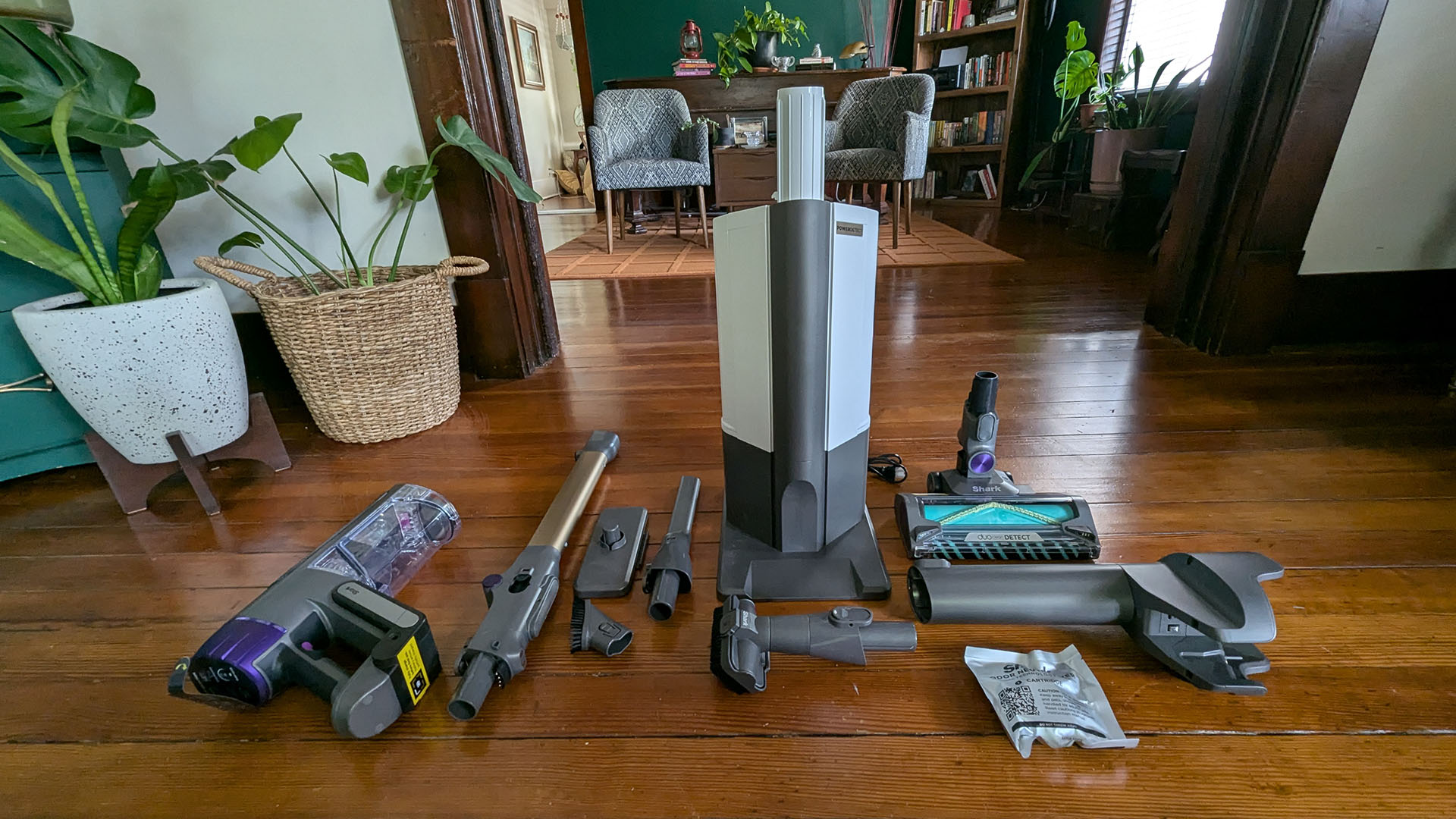
Shark PowerDetect Cordless review: price & availability
- List price (vacuum-only): $429.99 / £499.99 / AU$849.99
- Launched: Summer 2024
- Also available with optional auto-empty base
In the US, the Shark PowerDetect Cordless Stick Vacuum sells for $429.99, or $499.99 if you go for the version with the auto-empty base.
In the UK, it's £499.99 for just the vacuum, or £549.99 for the version with the special base.
Australian shoppers can pick up the vacuum for AU$849.99 or with an upgraded base for AU$999.99.
Based on TechRadar's price brackets, this is around the lower-premium / upper mid-range band (anything over $500 / £400 is counted as premium). Overall, I feel like the build quality and the features make this a well-priced vacuum. The DirtDetect system alone is well worth the investment. If you're on the fence about whether to shell out for the auto-empty base, I think the added convenience is well worth the slightly higher price.
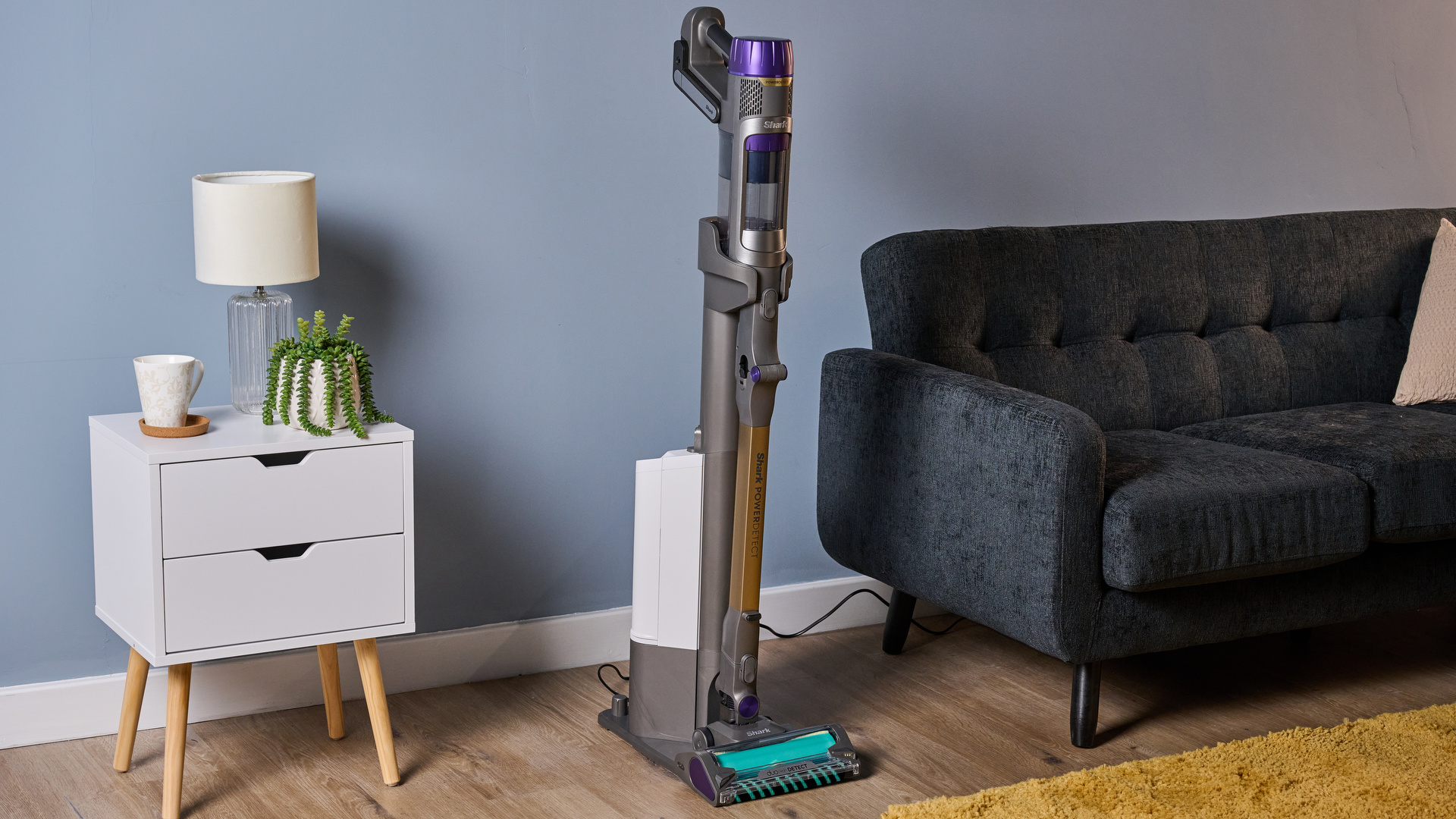
In general, Shark vacuums are much more affordably priced than, for instance, the best Dyson vacuums on the market – the Dyson V15 Detect has similar dirt-detection features, and a list price of $749.99 / £649.99.
In terms of comparable models within the Shark range, the Shark Detect Pro Cordless costs $379.99 / £349.99. It's a bit less powerful than the PowerDetect and it doesn't have the reverse-suction feature, but otherwise the detection/auto features are similar.
Alternatively, there's the Shark Stratos Cordless, which costs $499.99 / £349.99. It doesn't have the same detection / auto features as the PowerDetect, and I found the suction comparable too, so I'm not sure why you'd opt for a Stratos over a PowerDetect.
Shark offers discounts on occasion for its products. However, at time of writing this model is new out, so you might not see it discounted except during holiday and special sales events. Till then, look to the TechRadar Shark promo codes page for a deal.
- Value for money score: 4 out of 5
Shark PowerDetect Cordless specs
Shark PowerDetect Cordless review: design
- Operated by button; battery and mode info provided on a screen
- Bendable wand lets you effortlessly clean under furniture
- Optional auto-empty base
If you’ve used a Shark cordless vacuum before, you’ll quickly realize that the PowerDetect Cordless has many of the same Shark vacuum technologies that appear on other models, with a few improvements. Like most cordless vacuums, you can remove the wand and swap in another attachment for use as a handheld vacuum.
In stick vacuum mode, the PowerDetect Cordless is 46.3 inches long with a cleaning path width of 10.19 inches, and it weighs around 8 lbs. That's on the larger and heavier side for a cordless stick vac, although not excessively so.
The wand itself is unique among vacuums in that it is bendable (this is one of the most well-received Shark features, and it's included on many of its vacuums – not just the expensive ones). Click a button and it’ll bend forwards, allowing you to vacuum further under beds, couches, and other low furniture.
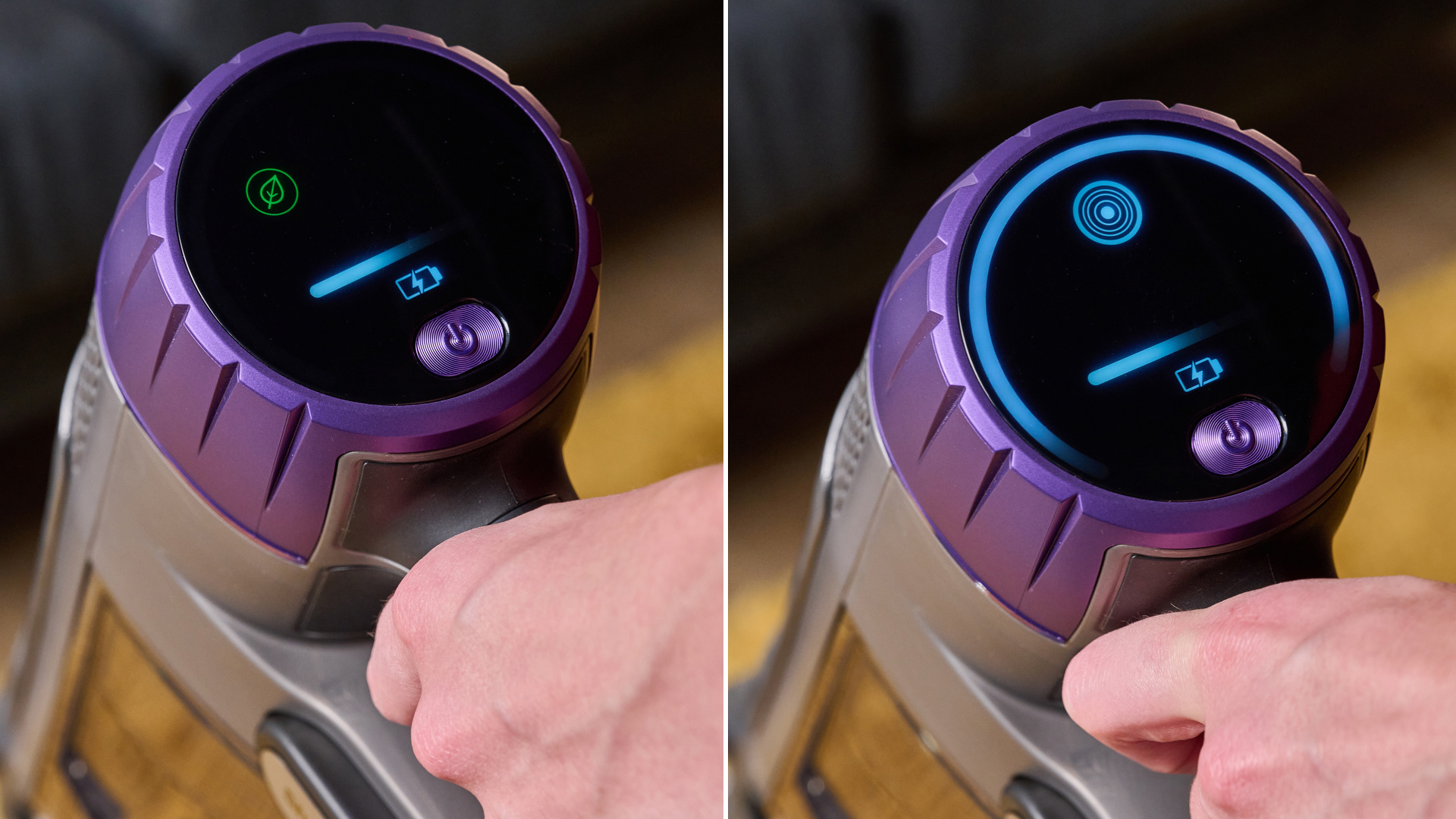
The Shark Cordless PowerDetect vacuum has a host of different detection features. The DirtDetect system can recognize hidden dirt and automatically boost the suction power in response. You can see when the floor is dirty and clean based on the colors – purple or white – that appear on the screen and around the vacuum head. With EdgeDetect, this Shark vacuum can sense edges and double the suction power along the side of the floorhead when it’s moving alongside an edge.
FloorDetect recognizes the differences between carpets and hard floors and adjusts the power depending on which one you’re vacuuming. Then there is LightDetect, which automatically increases the light on the vacuum when you clean in dark spaces (they're not as bright as you'll find on the – far more expensive – Dyson Gen5detect, though).
New to this model is 'reverse cleaning' – namely, while most vacuums just push larger debris around when the floorhead is being pulled backwards, the PowerDetect has some patented teeth that are designed to actively pull it in.
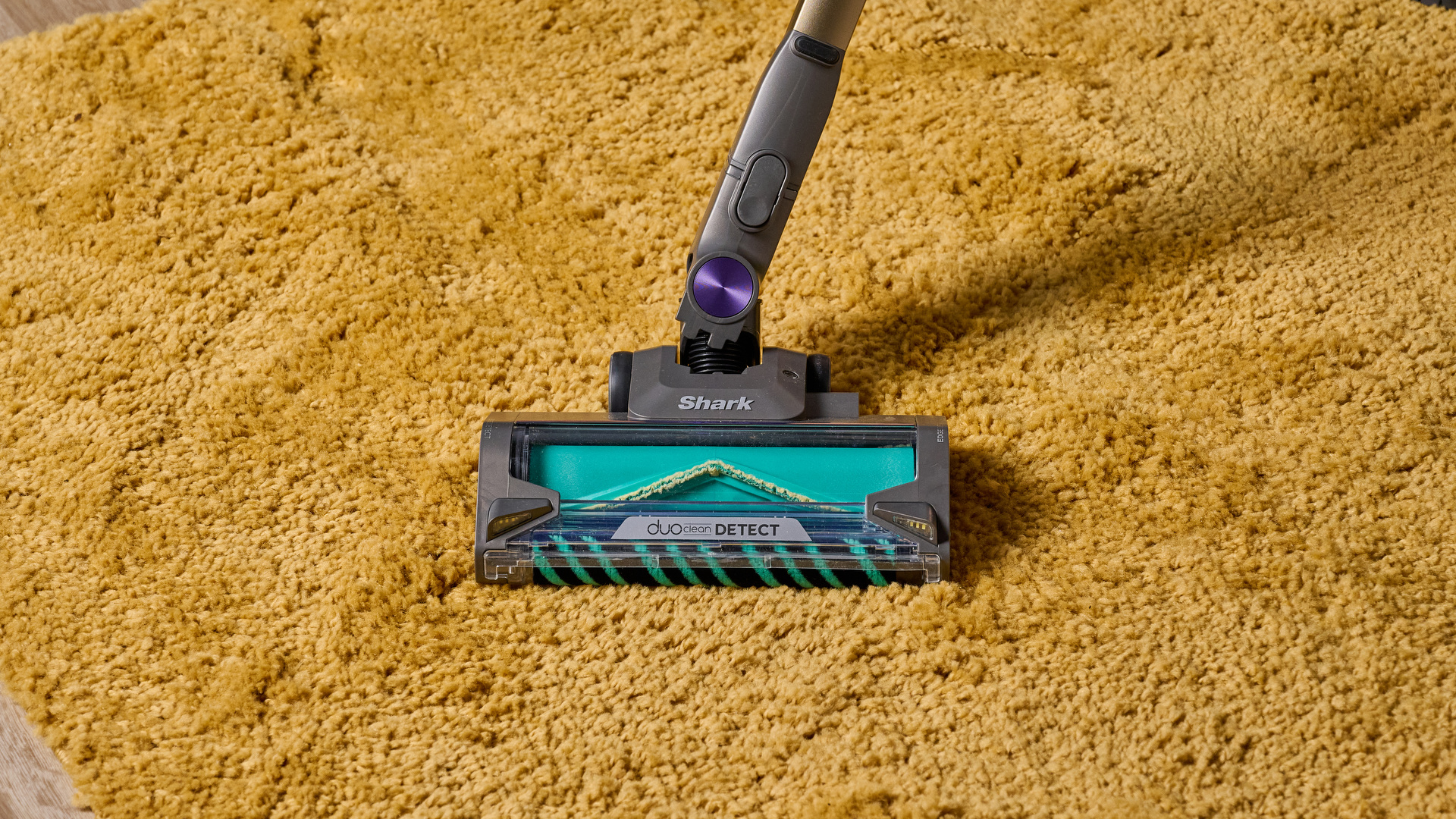
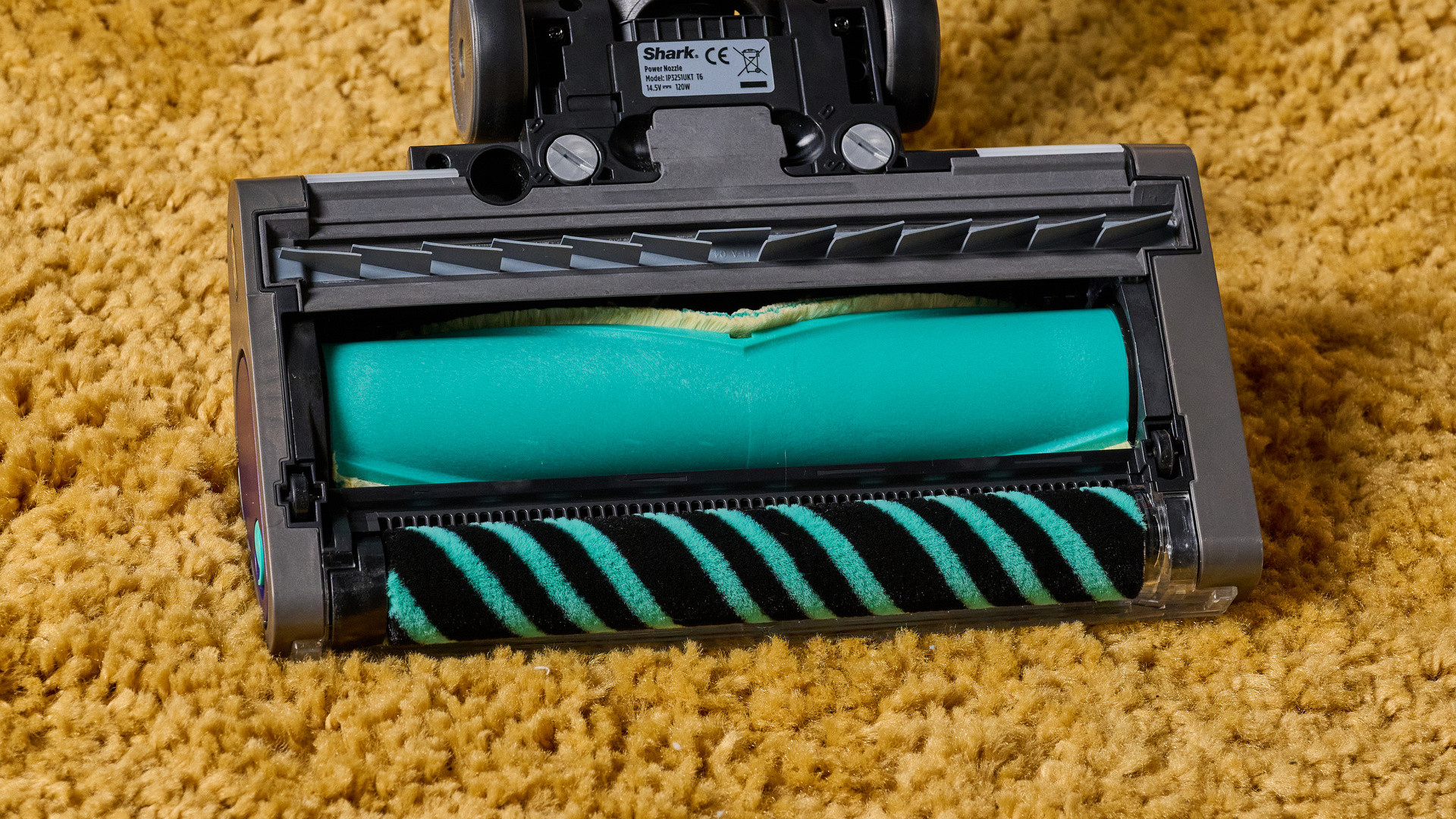
The vacuum is operated by a one-press button, and there's a trigger under the handle that lets you switch between the three modes. There's a low-powered Eco mode, high-powered Boost, and a DirtDetect, which is the one that auto-adjusts suction based on how dirty the floor is. The other 'detect' features, like EdgeDetect and LightDetect will kick in on any mode.
When the vacuum is turned on, the a circular screen shows which mode you’re in (a green leaf for Eco mode, red circle for Boost, or a radar graphic for DirtDetect), as well as a rectangular symbol noting battery life. It's not quite as clear as Dyson's version, which will literally spell out how many minutes of cleaning you have left in the mode you're currently using, but it's still useful.
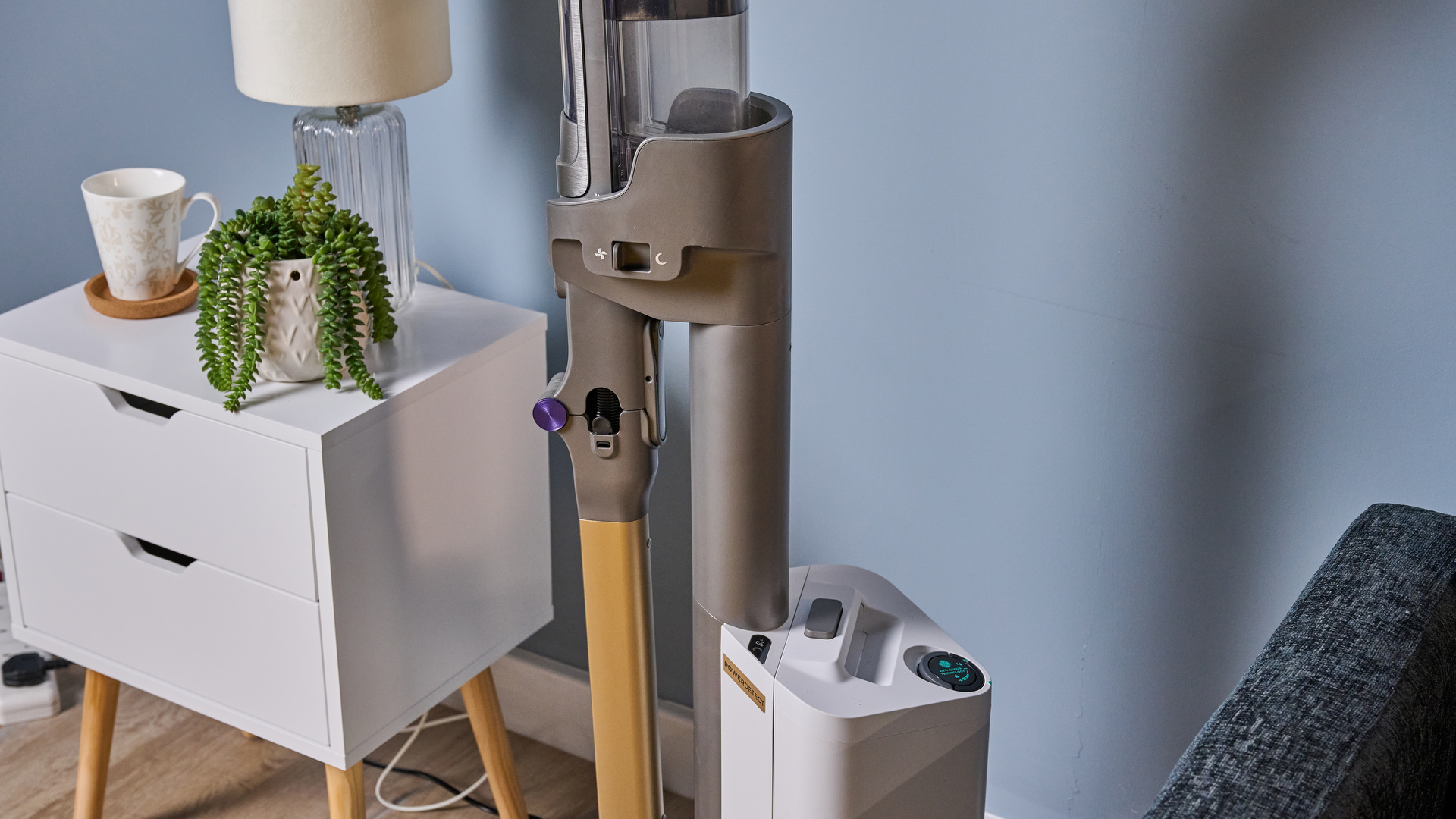
Tools can vary by region – my review model came with an 8-inch Crevice Tool and a Pet Multi-Tool. It's worth flagging that that there is an optional auto-empty base that I tested out. This is a new thing that Shark has been embracing lately. Dock the vacuum and the dirt from the bin will automatically be sucked into a larger chamber in the base, so you don't need to do it manually nearly so often. It also creates somewhere to store the vacuum, and charges it too.
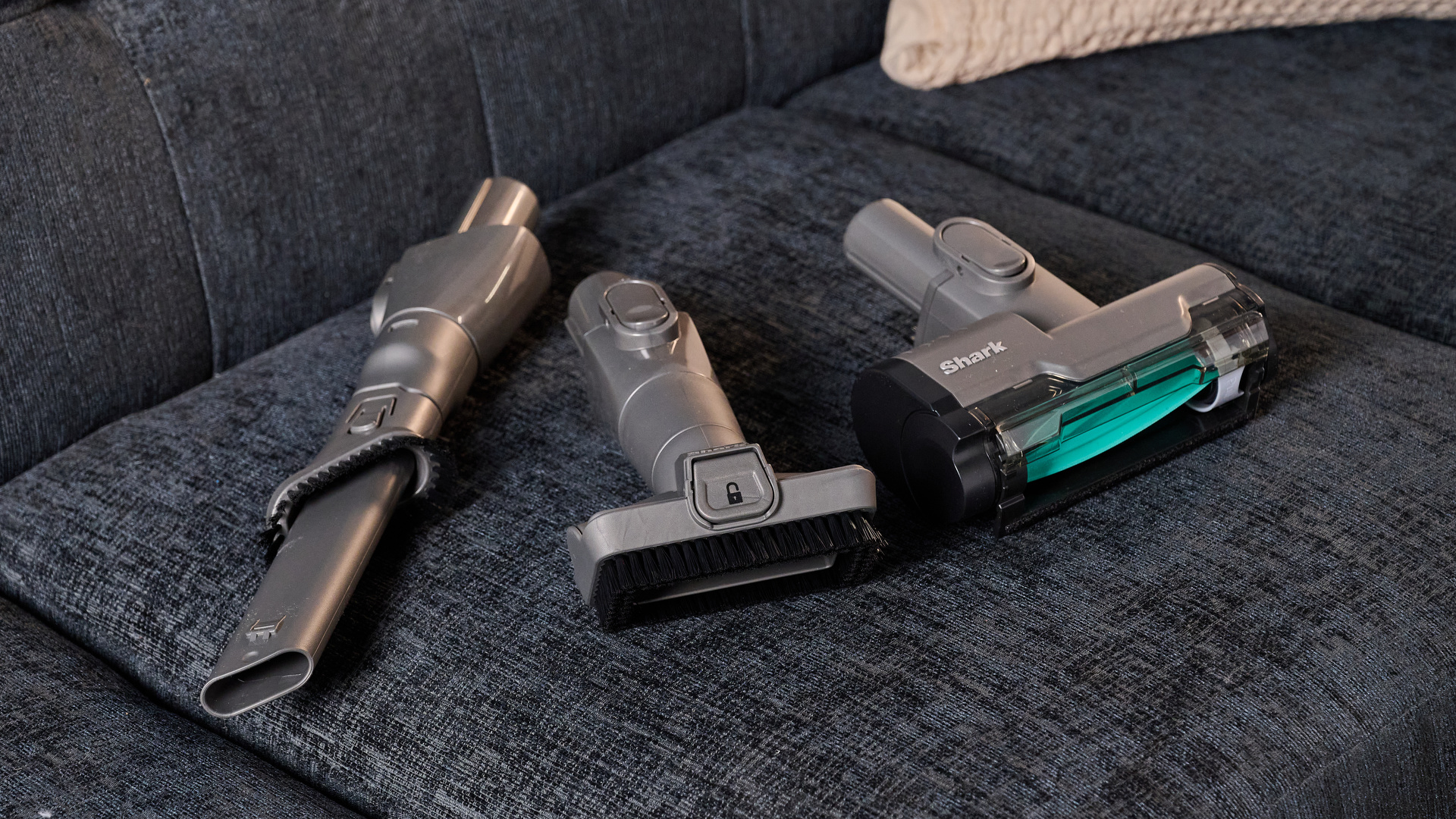
If you like the sound of the PowerDetect's features but want something slightly different, there's a PowerDetect Upright and a PowerDetect Corded Stick also in the range.
- Design score: 4 out of 5
Shark PowerDetect Cordless review: performance
- Auto adjustment features work well
- Good suction on both hard floors and carpet
- Comfortable to use; floorhead pivots pretty well
To determine the vacuum’s performance capabilities, I started by vacuuming my entire house, which is made up of historic hardwood floors, rugs, and laminate flooring. I noticed right away that the vacuum floorhead lights up automatically when the machine is running.
I found the vacuum easy to use, no matter whether I was using it as a handheld or in its typical cordless stick form. It switches on with the single press of a button, so you don't have to worry about holding down a trigger while vacuuming (a perpetual complaint with all but the very newest Dyson vacuums).
Despite being on the heavier side, it's comfortable to use and doesn't feel unbalanced. The floorhead pivots well and it's pretty easy to maneuver, although noticeably less nimble than the lighter Shark Detect Pro. It's also worth flagging that overall the vacuum is really quite tall. The wand provides a lot of length, which is nice for someone like me with 10-foot ceilings, although a little unwieldy in tighter spaces like hallways.
Part of the reason for the taller build is that the wand has a hinge built in to allow it to bend forwards with the push of a button. With this feature, I could reach under couches and chairs without having to lean over or squat down. The lights on the floorhead also got brighter when I vacuumed in low light spaces, which made it easier to see dirt, dust, and debris.
My favorite aspect of this vacuum is the DirtDetect system, because it increases the suction automatically when it detects dirt or debris. When this happens, the loop around the screen changes colors from white to purple (Shark claims the color is blue and not white, but I guess it could be a light gray blue), and the LED lights on the vacuum head match the colors on the screen. It is assumed that when the suction power returns to normal, the floor is free of dirt.
One of the advertised features is that this vacuum is meant to be able to vacuum just as well in reverse as forwards. On test, this worked very well, as you can see in the video clip above. The only time it struggled was with chunky breakfast cereal.
Whether this reverse cleaning it's a feature that's exclusive to the PowerDetect is another thing. It's noticeably better than the Shark Detect Pro, which has a floorhead that pools debris into little piles when pulled backwards, but I've definitely tested other stick vacuums that are just as good at vacuuming forwards as backwards, but it's not advertised as a specific feature.
With the 'EdgeDetect' feature, the vacuum will boost suction automatically near the edges of rooms. On test, I could hear the power ramping up when the floorhead reached a baseboard, and the lights on the relevant side would brighten to show what was happening, too.
Suction tests
It was important for me to run a number of tests to see just how well the vacuum could pick up various items from the ground. To do this, I taped a four-by-four-foot square on my laminate floor and on one of my large, thick rugs. I sprinkled each square with flour and then used the vacuum’s lowest setting – Eco – to suck up the flour.
When it came to the laminate floor, the vacuum picked up nearly every bit of flour on a single once-over. I saw only three specks of flour remaining when I was done. I didn’t notice any difference when vacuuming forward or backward over the flour.
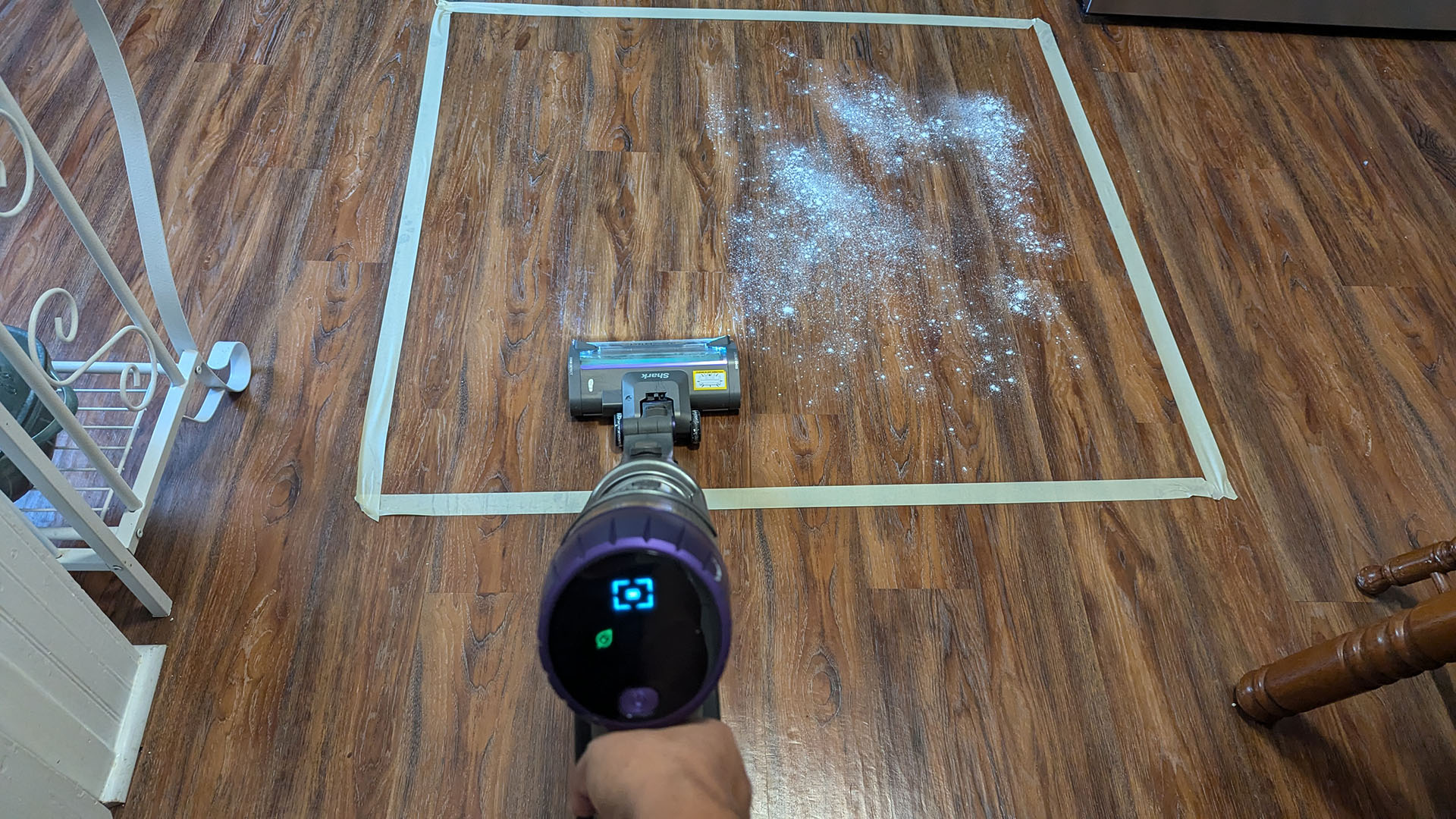
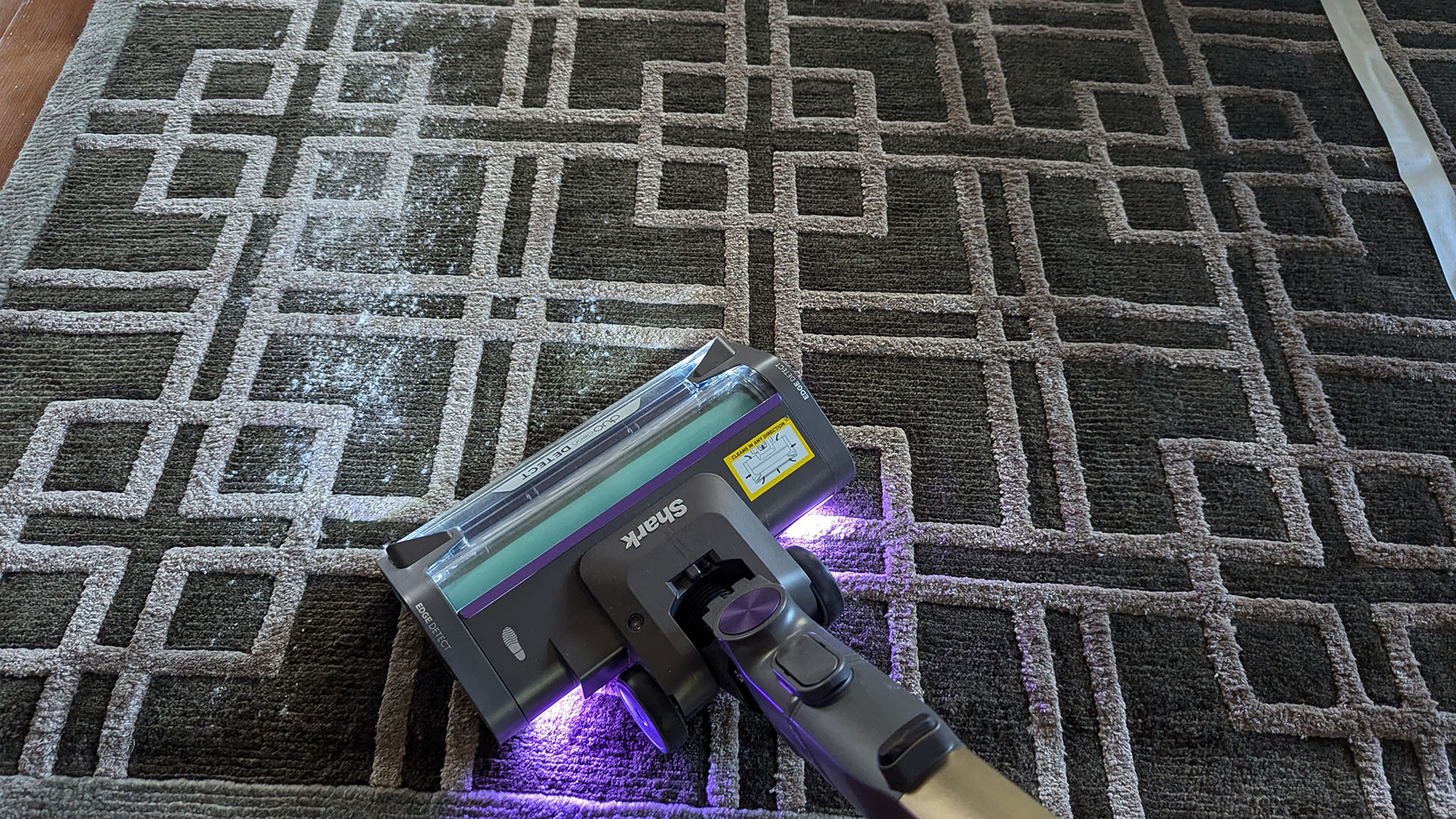
When doing this same test on a thick rug, I realized quickly that I was not able to use Eco mode, even though that was the setting I'd selected. The Shark vacuum recognized that I was vacuuming a rug and increased its suction automatically. There does not seem to be any way to prevent this. However, the vacuum did an even better job removing the flour from the rug in a single pass than it did on the laminate floor, as I didn’t see any flour remaining behind when I was done.
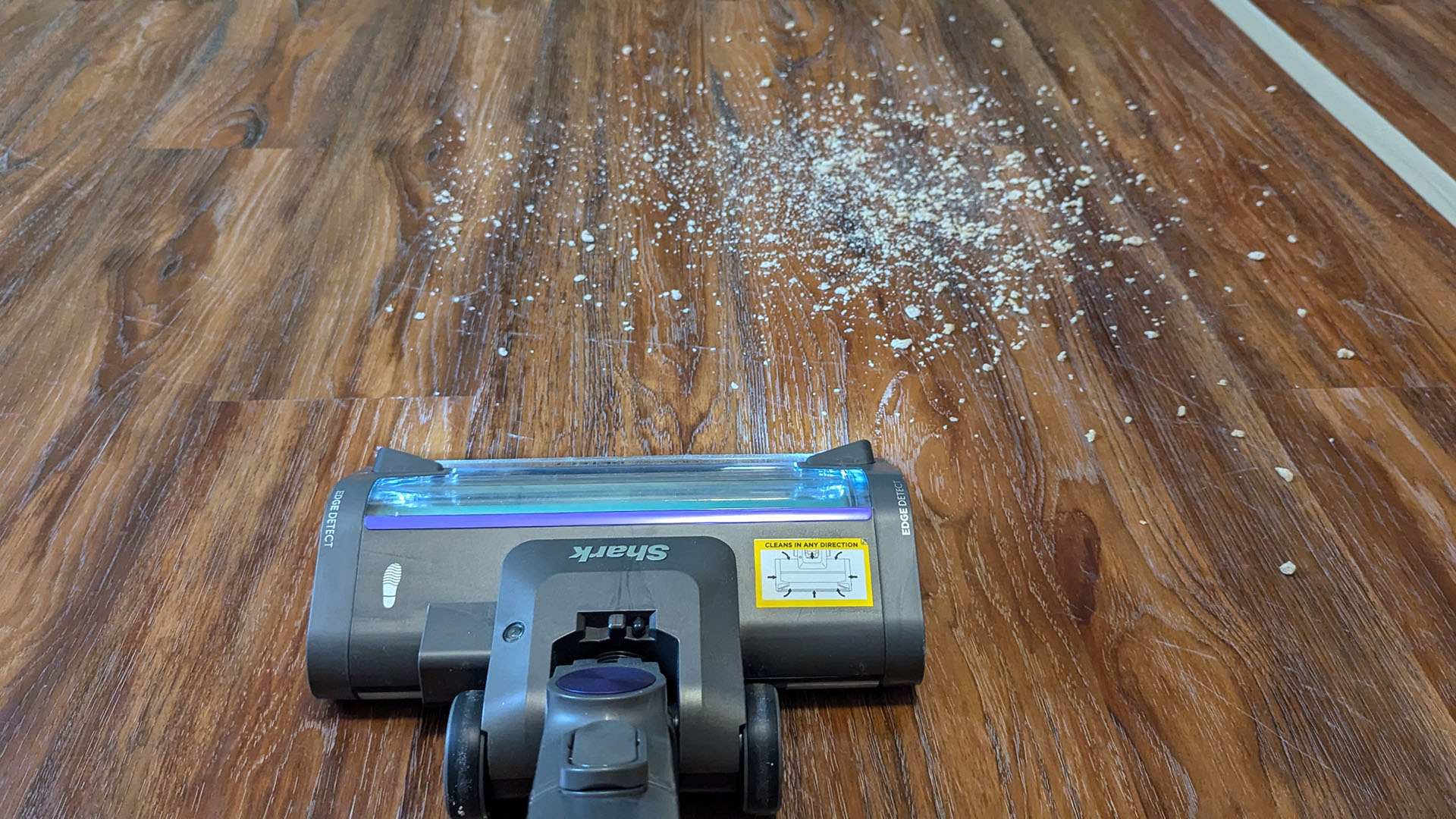
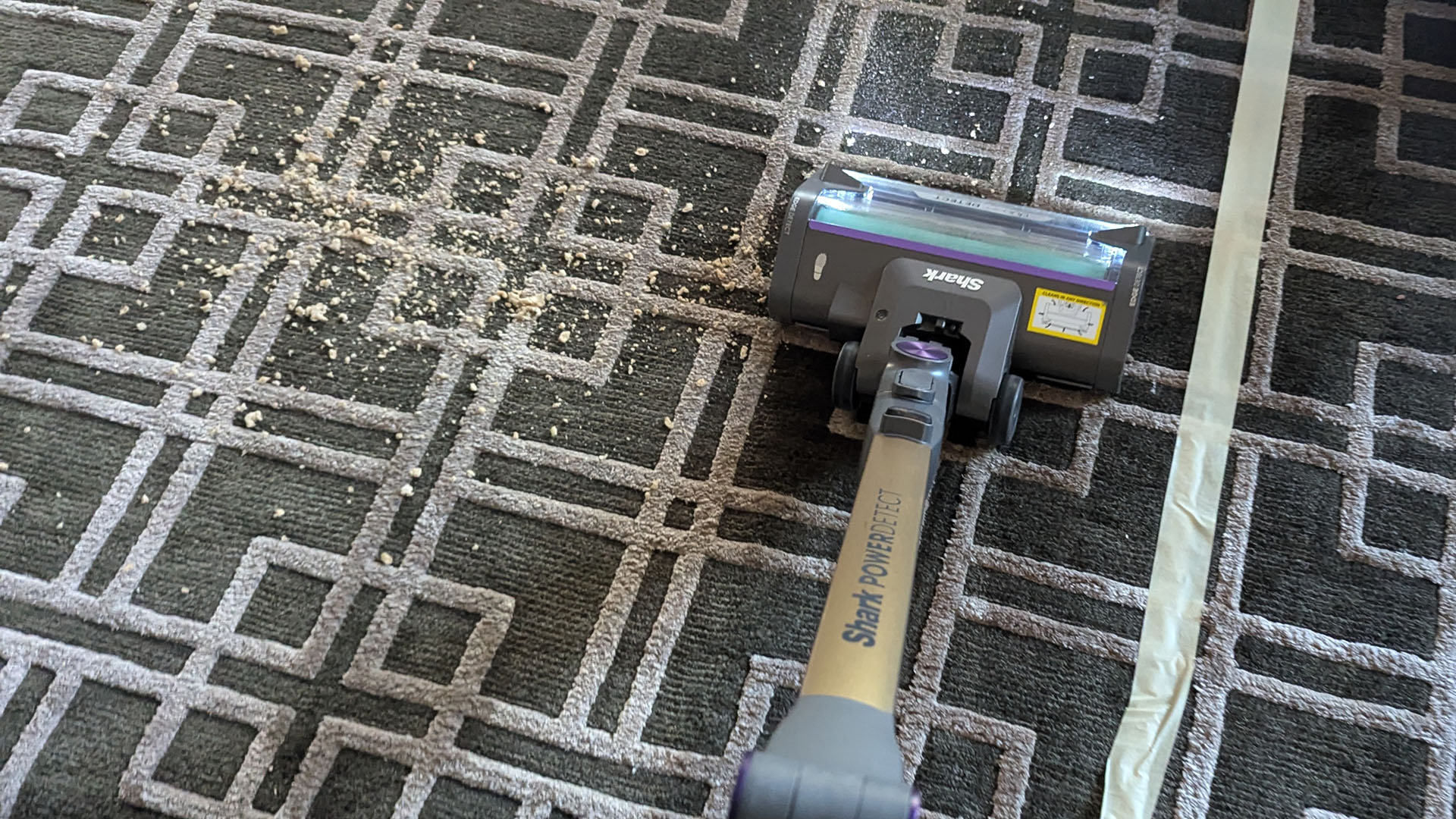
Next, I crunched up breakfast cereal (Cheerios, to be precise) and sprinkled them in both squares. Whether it was laminate flooring or the rug, the vacuum did a similarly superb job, especially when I vacuumed forward. If I pulled the vacuum backwards over the grinded cheerios, some of the larger pieces got stuck behind the wheels and thus were not suctioned up until I made a forward pass.
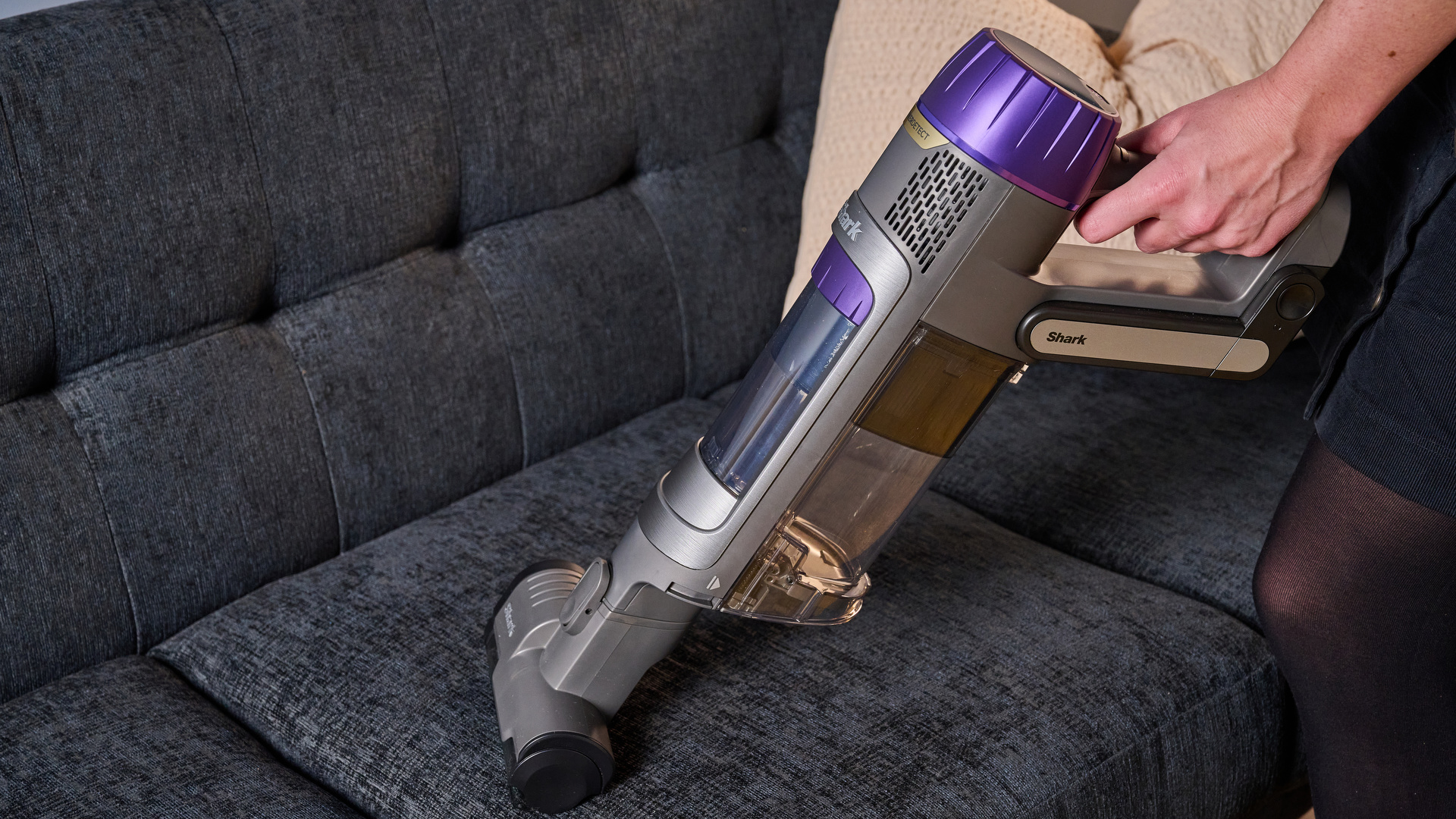
I didn’t notice any change in the suction capability of the vacuum when I switched it from a stick to a handheld with or without the wand attached. Two attachments were included with my review model – a Pet Multi Tool and a crevice tool. I don’t have pets, but a lot of my dark brown hair gets on my cream-colored couch. I used the Pet Multi Tool to remove my hair, and it did an average job.
I found myself scraping the hair a few times before it was suctioned into the machine. The Pet Multi Tool performed better on Boost mode. Admittedly, I’ve never tested a vacuum that could easily pull my hair off the couch, but I still wouldn't necessarily recommend it to pet owners (TechRadar's best vacuum for pet hair list has some alternative suggestions here).
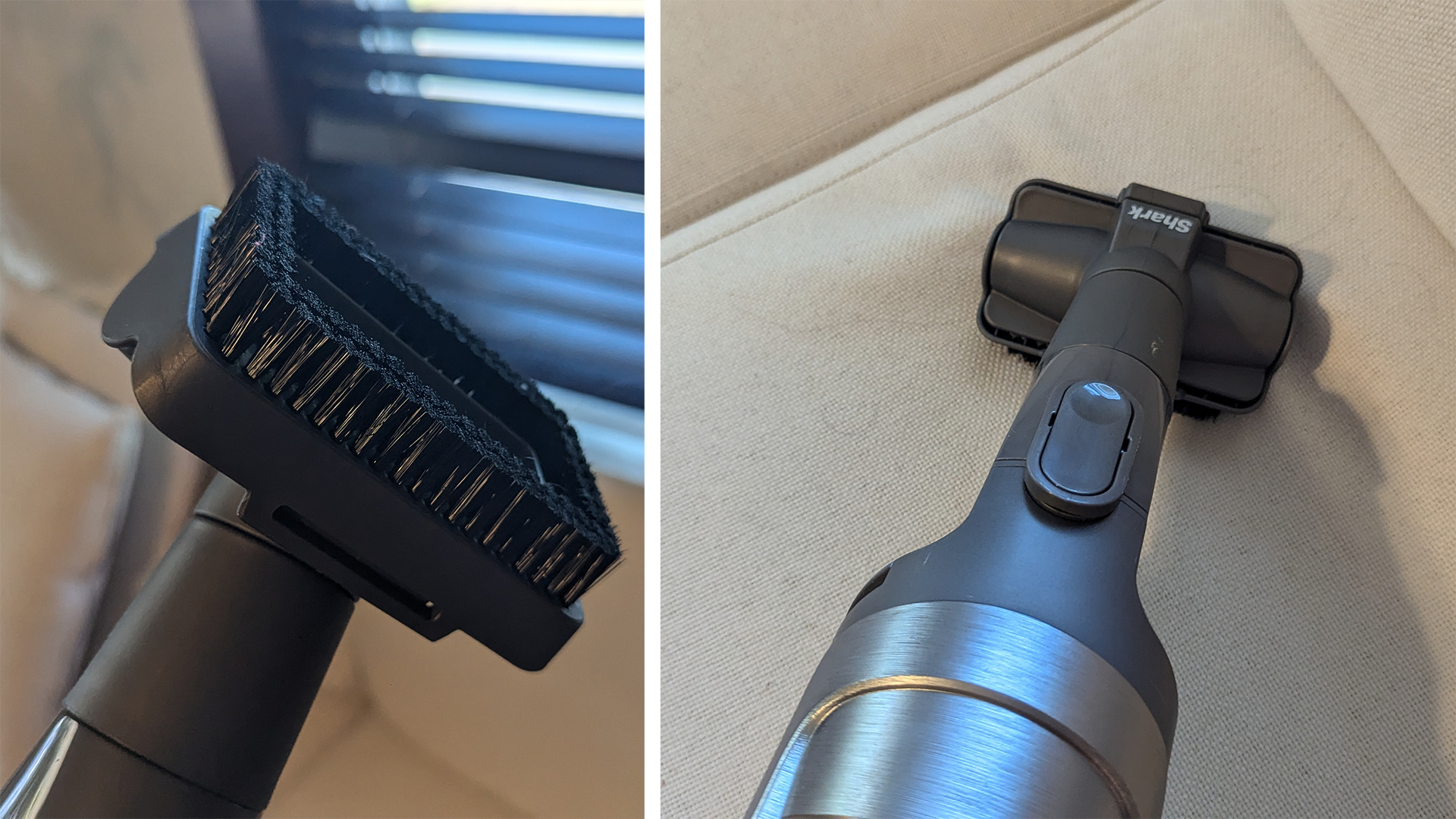
As for the crevice tool, I used this one quite a lot as I have a lot of furniture set in the corners of rooms. I was glad to see that the tool also has a brush. I used it to clean my baseboards and blinds with great success.
In DirtDetect mode, the vacuum has a 72-80 dB sound rating when cleaning hard floors and a 76-79 dB rating when moving over my rugs (this is due to the fact that the suction automatically increases when dirt is detected, which makes it noisier). The dB rating on Eco mode is 74 (you can’t use Eco mode on carpets, only hard floors). Boost mode has an 82 dB and 83 dB rating on hardwood and carpet respectively.
While not everyone will necessarily need it, I was so thankful for the convenience of the auto-empty system. When I was finished vacuuming, I placed the vacuum on the station and not only did it start charging automatically, but it emptied the dust and dirt from the vacuum into a sealed container. Whenever the container is full, I can remove it and dump the dust and dirt in the trash. It would be a strong recommendation for allergy sufferers, because there are fewer opportunities for particles to escape back into the atmosphere.
(Note that is it possible to store the vacuum freestanding without the dock: you can fold it over, using the bendy wand, for a more compact storage option.)
If you don't have the auto-empty dock, you'll need to remove the wand first and then hit a button when the bin is placed over a trash can.
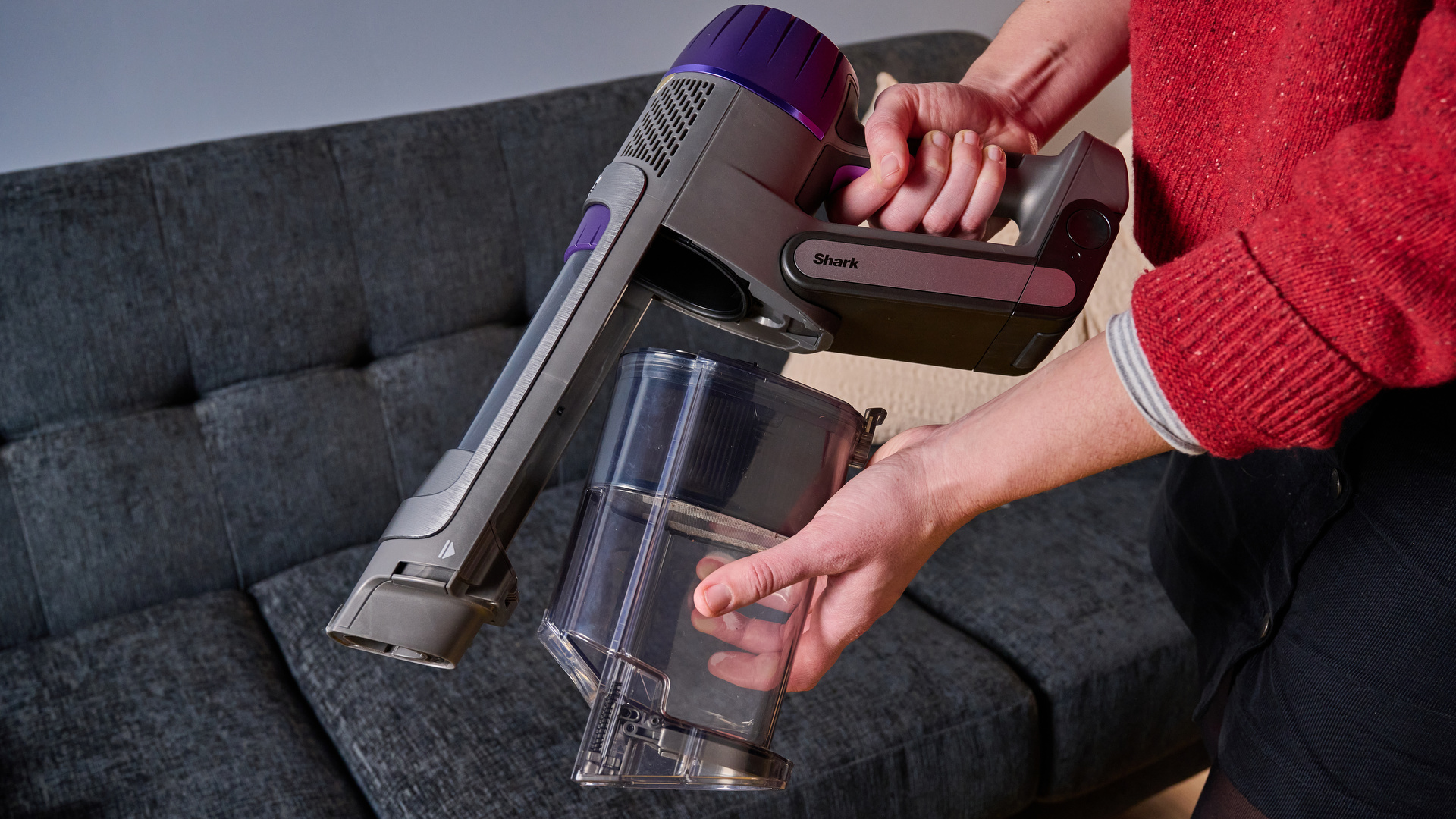
Maintenance is easy enough, even if there are a few tasks that you’ll need to do about once a month, like cleaning the brushroll and checking the wand for blockages. The onboard dust cup will need to be cleaned out, and you should also check the HEPA filter on the handheld to see if it needs to be rinsed or replaced. The filter on the auto empty station should also be rinsed and dried once a month and replaced regularly too.
Lastly, you’ll need to occasionally clean the sensors – the DirtDetect system sensor is inside the dust bin of the vacuum, while the LightDetect sensor is on top of the vacuum head, and the two EdgeDetect sensors sit along the sides of it.
- Performance score: 4.5 out of 5
Shark PowerDetect Cordless review: battery
- 4 hours to fully recharge the battery (using auto empty station)
- Battery lasts 14 mins in Boost, 1hr 7 mins in Eco
- Eco option not possible on carpet
One of the most impressive aspects of this vacuum is the battery life. Shark claims it'll last a maximum of 70 minutes in Eco mode, although that's in handheld mode. On test, it managed almost that long: I clocked 67 minutes, although that was with a wand attached. Anything over an hour is a really strong battery time for a cordless vacuum (assuming the suction is still decent, which is true here). However, remember that Eco mode won't work on carpets or rugs, so if you have a home with soft flooring you won't achieve these times.
When I ran the PowerDetect entirely in Boost mode, the battery lasted 14 minutes. That's actually not bad for a maximum power mode; it's only designed to be used on the toughest, ingrained dirt. If you use DirtDetect mode, runtimes will vary based on how dirty your floors are an how much suction the vacuum needs to use.
On an average clean, I found this vacuum lasted around 47 minutes, which involved me switching between the lowest and highest power settings. That'll be more than enough time to clean most homes in one go.
It took about four hours for the vacuum to completely charge. Shark doesn't provide recharge times, but a listing on Best Buy said it'd take 6 hours. I was glad to discover that charging did not actually take that long. Over time, it’ll likely take longer for the battery to charge. It’s not unusual among vacuums on the wider market to take 4-6 hours to charge.
- Battery life score: 4.5 out of 5
Should you buy the Shark PowerDetect Cordless?
Buy it if...
Don't buy it if...
How I tested the Shark PowerDetect Cordless
I tested this vacuum for over a week in my house, which has a mix of historic hardwood and laminate flooring, some of which is covered in large, thick rugs. I ran a number of tests such as using the vacuum to pick up flour and crushed Cheerios, and utilized the attachments to clean my couch of hair and dust from hard-to-reach places. I compared the results to other vacuum cleaners I've reviewed in the past. By running these tests and others, I was able to provide an in-depth review.
Read more about how we test
First reviewed September 2024







